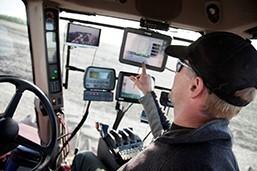When U.S. farmers replaced their horse-drawn equipment with tractors in the early 1900s, their crop productivity took a mighty leap forward. Technology on the farm has continually evolved to increase efficiency, improve yields and drive production and profitability. In the 21st century, this is due in part to the development of precision agriculture tools.
The U.S. Department of Agriculture (USDA) defines precision agriculture as an “information- and technology-based agricultural management system used to identify, analyze and manage variability within fields for optimum profitability, sustainability and environmental protection.� Essentially, precision agriculture allows producers to specify input needs including nutrient and pesticide application, tillage and irrigation throughout individual fields. In addition to cutting production costs and saving energy, precision agriculture reduces soil erosion and environmental pollution and improves water quality by reducing nutrient runoff.
The latest precision agricultural tools include technologies made possible by GPS, which support mapping programs to capture detailed information; automatic steering that allows for hands-free operation and guidance of tractors, sprayers and other equipment; and variable rate technology (VRT) in both seeding and chemical application equipment. Farmers choose among these new tools to meet production goals by evaluating what is best for their individual farms.
North Dakota farmer and businessman Neil Bernhoft believes there are many benefits to automatic steering.
“It has changed the game tremendously,� he said. “Auto steer reduces operator fatigue, increases accuracy and allows for more focus in other important areas. Farmers can actually put more hours in with the help of this technology.�
The most recent USDA data indicates automatic steering was used on 52 percent of planted U.S. sorghum acres in 2011, 45 percent of planted U.S. corn acres in 2010 and 43 percent of planted U.S. barley acres in 2011.
Fields typically vary in soil type and chemistry, elevation, fertility and productivity. By using VRT available for equipment such as planters and chemical applicators, grain producers can pinpoint input needs throughout an individual field and optimize the application of seed, fertilizers and crop protection products. The use of this technology reduces input usage, lessens environmental impacts and increases overall efficiency.
Timely and accurate information is one of U.S. farmers’ most valuable resources. Yield monitors and the mapping applications that interpret the data collected by them show farmers both the strong and weak locations within a field. The combination of yield maps, aerial imagery and VRT strategies provide information for farmers to develop field management plans.
“Data is a huge player in the industry,� Bernhoft said. “Accurate data collection is the key to making informed decisions.�
Bernhoft believes precision technology will help farmers become even more customized in their work in the future.
“Farmers will continue to utilize these tools to capture and review information about their fields, and develop strategies acre-by-acre, rather than by the field,� he said.


